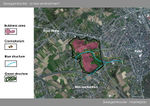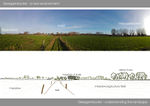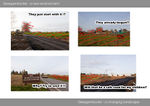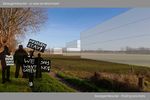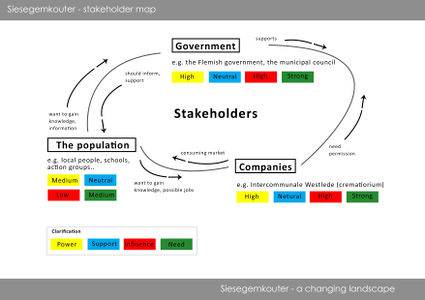Landscape Democracy 2015 Working Group D - Case Study 2
---> back to group page working group D
Please add the title of your case study here, adjust the map coordinates (lat + lng) and replace the moa image with a characteristic image of your site
| Place name | Siesegemkouter | |
| Location | Aalst | |
| Country | Belgium | |
| Author(s) | Jan Persoons | |
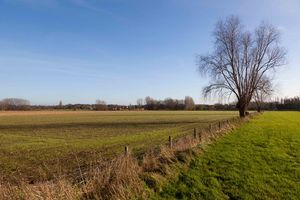
| ||
|
| ||
Rationale: Why have you chosen this case for the landscape and democracy seminar?
The surroundings of Siesegemkouter are a perfect place for a landscape democracy case. For over ten years, people have been standing up for the preservation of this area. Why? The 'Siesegemkouter' is a landscape typical of Flanders (the northern part of Belgium). It consists of agriculture fields and some small forests. The loss of this environments would involve a major change in the landscape surrounding the villages of Nieuwerkerken, Erpe-Mere and the city of Aalst. Local government wants to integrate a business area in this region. They argued: "the implementation of this business area will be a good thing for the city". While this may be true, it will create approximately 1300 new jobs and 45 ha of space for businesses. One important argument is overlooked. This place will never be the same again. Multiple properties will be expropriated and a lot of nature will irretrievably disappear. Thus a reconsideration between local government and the population of the area about the Siesegemkouter masterplan is necessary.
Representation of your observations
- you are basically free to use one or a mix of different presentation techniques
- possibilities are: analytical drawings, graphical representations, collages, video clips, comic/graphic novel, written essay/visual essay
- please add any visual material to the gallery, videos can be placed below, you may add text as you like
- Observations
Reflection
What are the major challenges for changing the situation?
The challenge is to combine a business area with the original local surroundings. This means ensuring connections for transport, allowing for enough green and blue structures and the nearby surrounding that borders some villages. The proposed business park will create new jobs, but it will only work if the traffic problems are solved. New roads for cars, trucks and public transport are necessary as well as safe bicycle paths from the city and village towards the business area. Green and blue structures are necessary to compensate the loss of the agriculture fields and trees. According to the Siesegemkouter masterplan Siesegemkouter, there will be the strict minimum of green and blue structures. Green structures consists of trees, shrubs and grasses, all typical for a situation that fits a business park and the original environment. The 'blue' structure consist of the original creek, some new water basins and areas where water can infiltrate. Good examples of other business areas are welcome to make this a healthy area for human, animals, nature and environment.
What could be a starting point for democractically-based change?
The starting point for a democratically-based change is conversation and communication. The main reason why people are still protesting against the Siesegemkouter masterplan are bad and few communications to the public. The people of Aalst, Erpe-Mere and Nieuwerkerken need more information about this project. With that information, a debate can be started about adjustments of the plans. This will, of course, not be enough. A visit to the site with the local government and the people of the surrounding village will be a next challenge. Some new problems might arise, but that is normal. It is better to foresee a problem before realization rather than afterwards. Local farmers and people who will lose their ground, need to be informed about compensations. Another way to discuss the future implementation of the terrain is a workshop where people can suggest their own thoughts and ideas. Only then, a positive solution for creating a sustainable environment is possible.
Stakeholder Mapping
Create a visual representation of the stakeholder groups that are involved in your case. Try to cover the following aspects in your representation: Power (high, medium, low) / Support (positive, neutral, negative)/ Influence (high or low)/ Need (strong, medium, weak)+ also map the relationships between the stakeholder groups
- Stakeholder Map
Change Scenario
Look at the various methods and tools available and think how they can be applied creatively. Think about the needs of different stakeholder groups - you may need a methodical mix to address them all. Visualize a scenario illustrating how these methods/tools can be applied within an imagined time frame
- Change Scenario
Cross cutting theme
A common topic is the so-called 'conflict of interest' amongst the financial interest, the lack of public participation and the spatial part. Without financial government support (140.000 Euro), it will be hard to carry out this masterplan. Due to the bad timing, wrong communication, the public was not well informed. The Siesegemkouter masterplan is designed by an Italian architect office, which had no feeling with the needs of the local citizens and the historical influence of prime agricultural land. Their focus is based on urban development rather than the harmonic combination of both urban and rural areas. The municipal council is in charge of the project. So they are responsible for the right choices to make connecting to a future, sustainable environment.
Concluding reflections
This case study of the Siesegemkouter has both potentials and limitations. There is room for improvement, designing a communication plan for instance. This would clarify a lot of discussions about the implementation. With the changing model, stakeholders, local citizens and the municipal council will work together in order to have a better result. This will reflect in workshops, feedback moments, an area visit and a common design for a masterplan with the help of a landscape architect office, which is specialized in such designs. It will be too late for this case. Lessons, however, can be learned for the future. Further fragmentation of Flanders is a non-stoppable process. It has his limitations, as will be proofed by this project. Only well, common projects can be implemented by further cooperation between stakeholders and local citizens.
References
* Please make sure that you give proper references of all external resources used.
* Do not use images of which you do not hold the copyright.
* Please add internet links to other resources if necessary.
About categories: You can add more categories with this tag: "", add your categories
